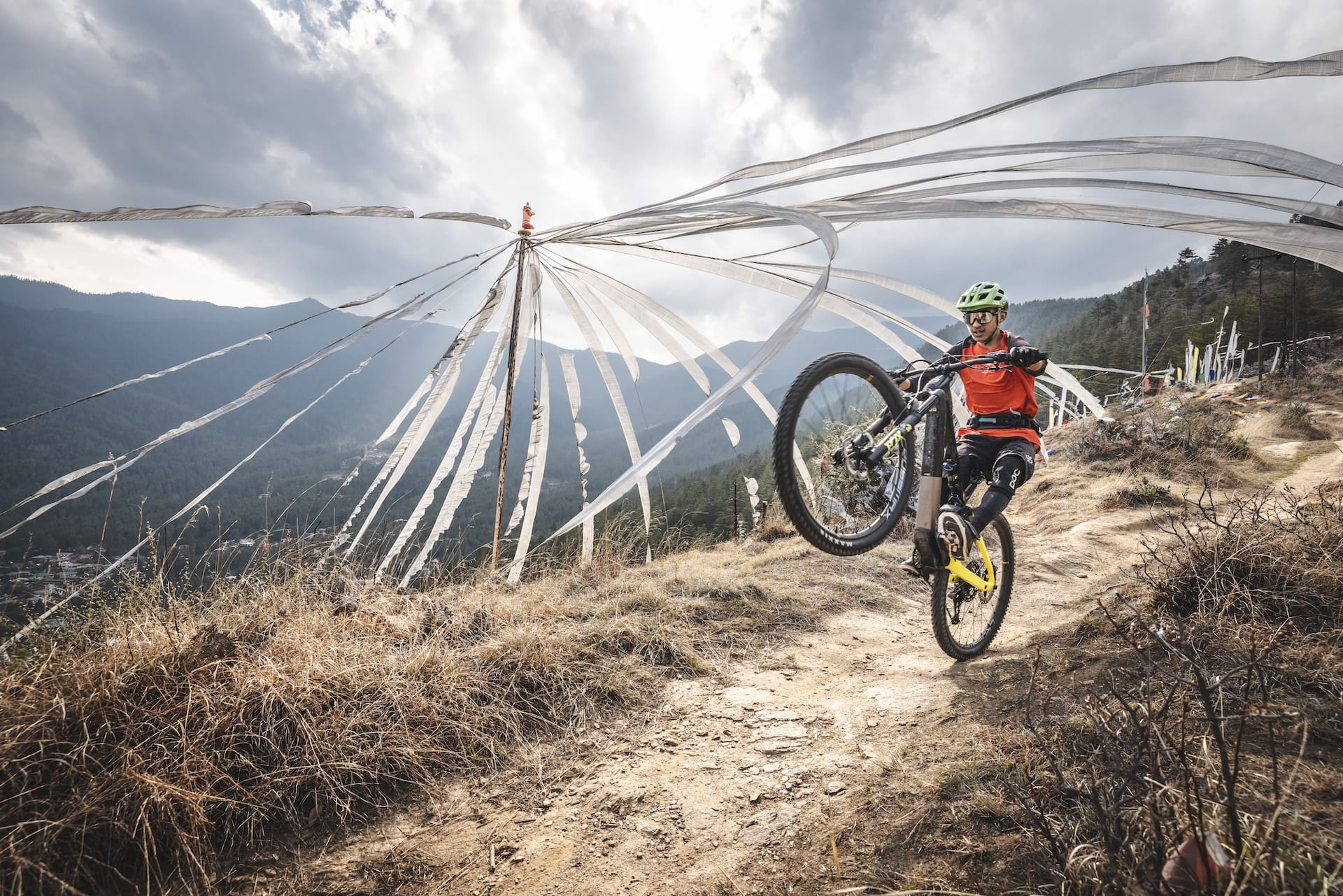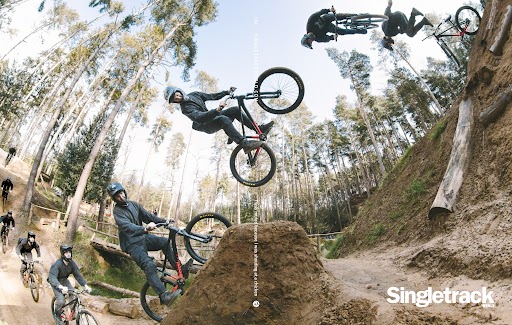Since Bhutan is keen on measuring happiness, it should be no surprise that there is great mountain biking to be found there.

Words and photos by Martin Bissig
The small kingdom of Bhutan, nestled in the Himalayas between India and China, is shrouded in myths. It’s said that entry visas are deliberately limited. Bhutanese people are often considered the happiest, as their government prioritises Gross National Happiness over Gross Domestic Product. The famous Taktsang Monastery is believed to have been established where a guru landed on the back of a tigress in the 8th century. And yes, the country is adorned with conspicuous phallic symbols, seen as murals or sculptures everywhere. One day, as if to outdo the legends, my friend Tom Öhler called. “I heard the Prince of Bhutan is an avid mountain biker who builds trails himself. You’ve been there several times. Let’s check it out.” A perfect reason for me to visit Bhutan again and explore the myths first-hand.
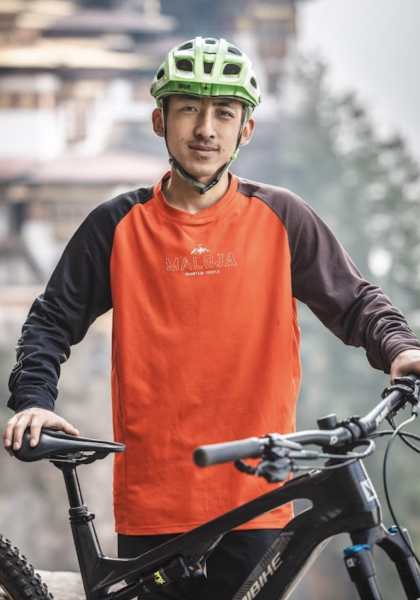
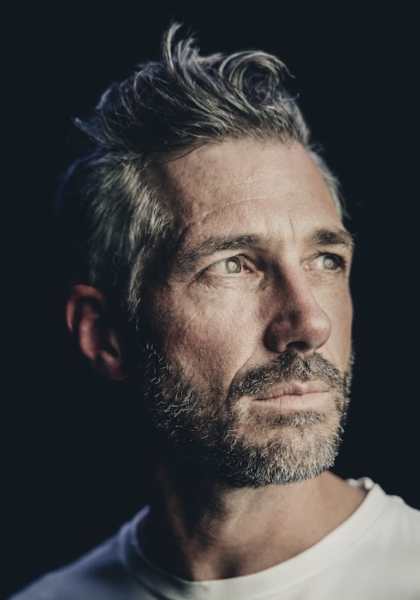
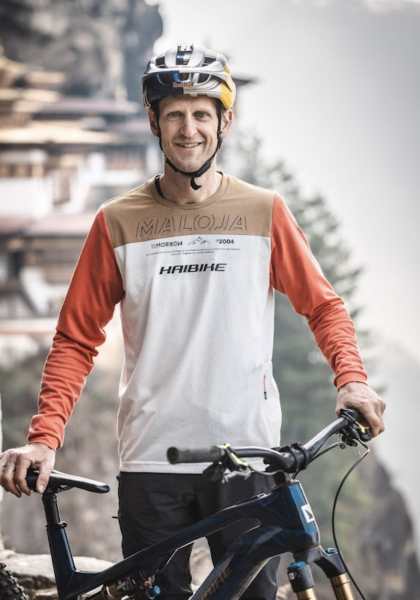
Tandin Wang – Martin Bissig – Tom Öhler
Welcome Back!
This was my fifth visit to Bhutan, with my last there being back in 2010. On my first visit, the country was still fresh and unspoiled – television and the internet had only been introduced eight years earlier. The King of Bhutan had done his best to shield his small nation from Western influences. I remember that my visa from October 2007 bore the number 20,244. The kingdom was visited by as many tourists in a year as Disneyland in California sees in a morning.
Tourist numbers were never limited by quotas but by a sustainability fee charged per guest per day. Compared to Nepal, a trip to Bhutan is much more expensive and thus more exclusive. The hotels back then were clean but quite basic. Wi-Fi? Forget it! Even driving on the winding, bumpy roads was a grand adventure. The reward was the actual exclusivity at the sights and monasteries, and the incredibly open-hearted and friendly contacts. Often I travelled completely alone with my guide and driver. No cyclists to be seen anywhere. I couldn’t have imagined returning almost 20 years later, on a completely different mission: searching for royal trails!
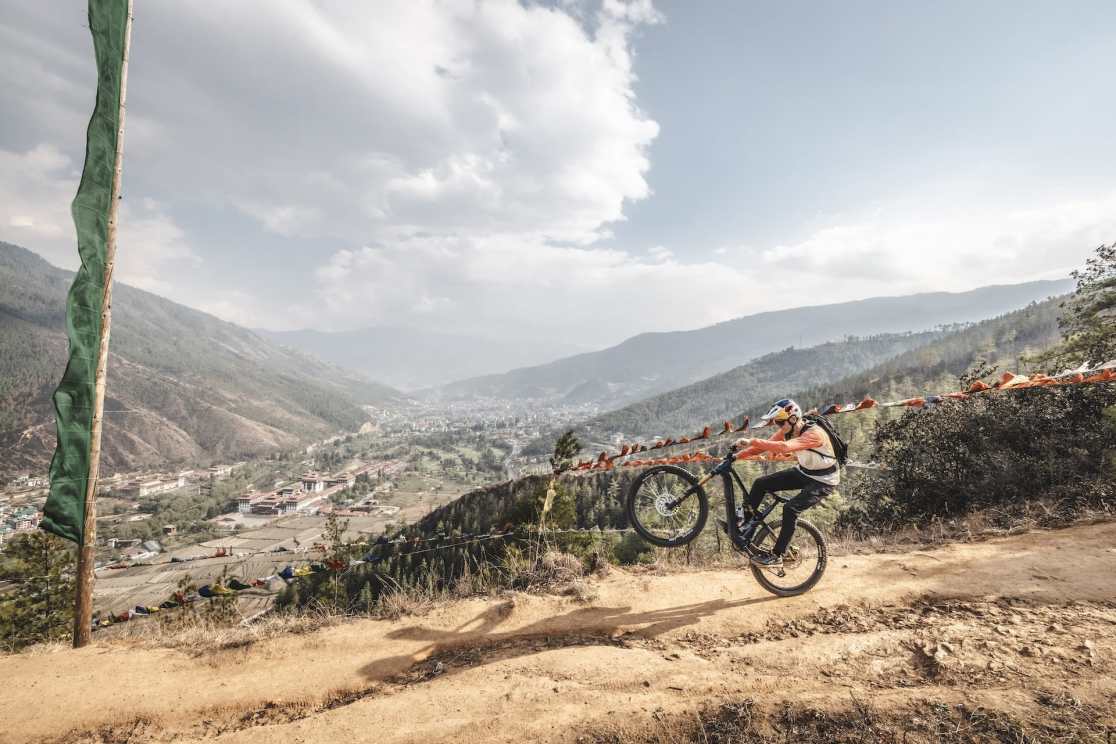
Tom had already arrived in Thimphu, the capital, a day before me. Since our phone call, he has connected with the local bike scene through Instagram. From past projects we know this – stick to the rear wheel of a local, and you’ll find the best trails in the area. Our initial uncertainty about finding a suitable Bhutanese counterpart for Tom quickly vanished. With Tandin Wang, we not only found one of the best local riders but someone who competes at the top level in enduro races across the Central Asian region. As a mountain bike guide, he knows not only the trails around his home but has explored all of Bhutan with guests. The best conditions to discover the best bike loops.
Urban Acclimatisation
First on the agenda are the trails around Thimphu. Here, Tandin and his buddies are shredding almost daily. The biking scene is small but highly motivated. Tom and I are amazed at the incredibly good condition of the paths, which have mostly formed naturally over hundreds of years. In ancient times, they were often the only connections between villages and monasteries. Today, they serve mostly as trekking routes for tourists from around the world – and recently also as mountain bike trails.
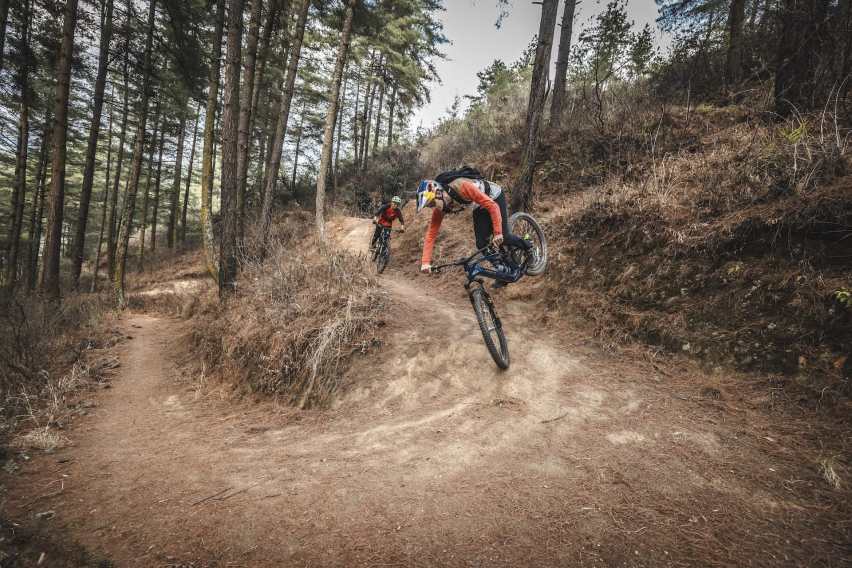


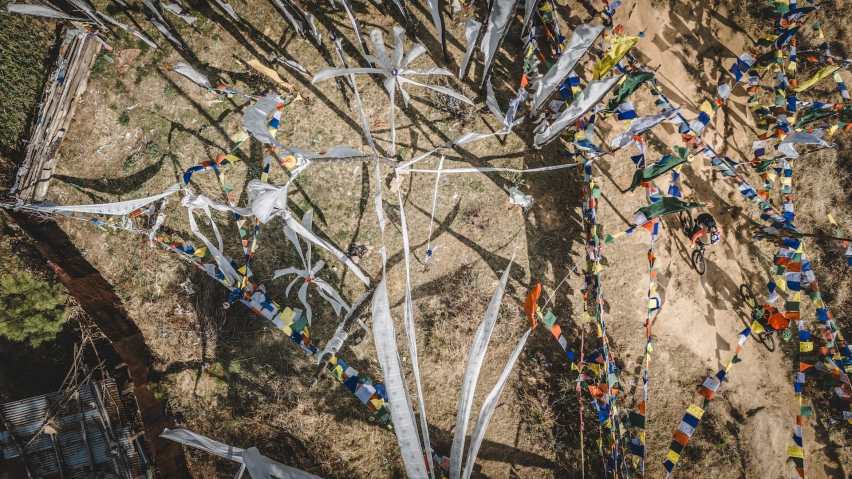
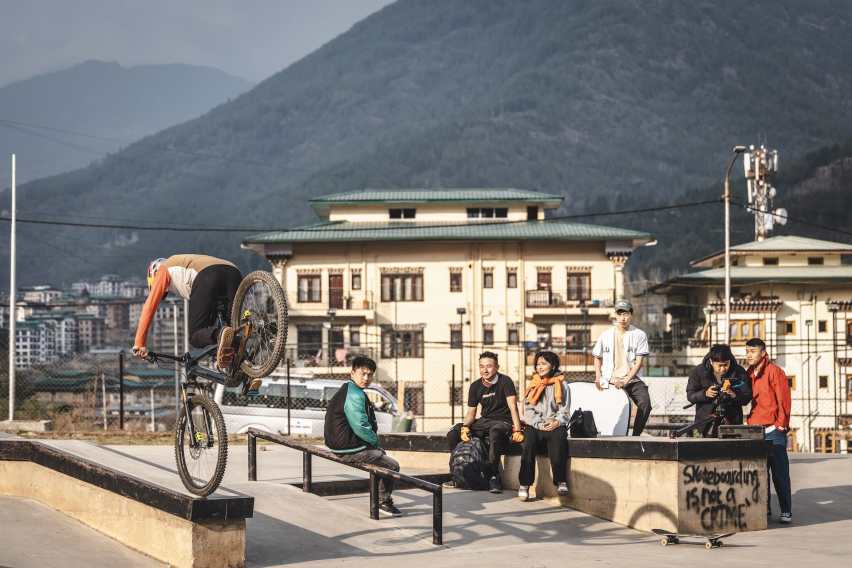
On a windy mountain ridge, we laboriously push our bikes up. Tom and I pant behind Tandin. “You completely forget we’re over 2,500 metres high here,” Tom puffs. After a longer pushing section, we finally reach the trailhead at over 3,000 metres. The expanse of Bhutan’s largest city becomes apparent. Almost a fifth of the country’s nearly 800,000 inhabitants live in the capital and its surroundings.
“From here, it’s all downhill, enjoy!” Tandin calls out and pedals off. Tom struggles to keep the rear wheel of the rider in front in sight on the dusty paths, as the local champion knows every inch of the trail. The path is lined with prayer flags fluttering rapidly in the wind. Through a corridor of white, blue, red and yellow flags, the two race into the valley. Suddenly, we round a corner and stand before a temple. A scene like out of a video game – it all looks so unreal. I snap a few photos, but we barely have a moment to catch a breath and move on quickly – there’s not much time before sunset. Before we reach our destination, the urban skatepark, we pass one of the largest sitting Buddha statues in the world, towering over the city and protecting it. Wow, what an introduction to Tandin’s biking world! And for Tom, a good preview of what Bhutan has to offer.
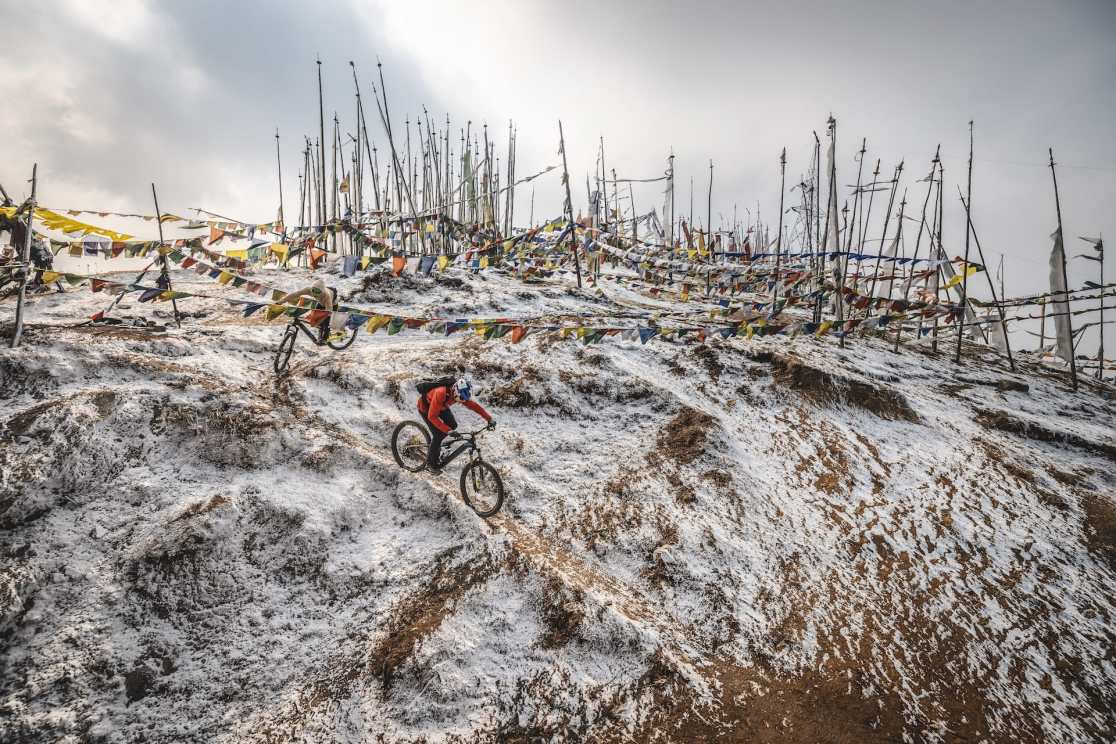
Bitcoins on the Madman Trail
In the first few days, we encountered little off-road traffic and were generally surprised at how few foreigners we saw, even in the big city. The country hasn’t fully recovered from the pandemic tourism-wise. The increase in the sustainability fee for tourists to $200 per day per person certainly didn’t help and was cut in half after a few months.
“You think that was few people? Wait till I show you my favourite trail, we’ll be almost completely alone,” Tandin tells us during the briefing for the coming days. The next morning, our shuttle picks us up early. On a winding road, we leave the densely populated area behind and slowly ascend to Dochu La Pass. Before reaching the pass, we leave the main road and enter a dense forest. After a few minutes, a loud humming sound breaks the silence, right in the middle of nowhere. “This is top secret, guys. Our state runs one of the few Bitcoin farms here,” Tandin reveals. Photography is strictly forbidden! Through the trees, we see the inconspicuous buildings, which sound very conspicuous. A quick internet search confirms Tandin’s statement. It’s not that secret, but no one really wants to talk to us openly about the Bhutanese crypto industry. No matter, we’re here to ride trails, not look for an investment.
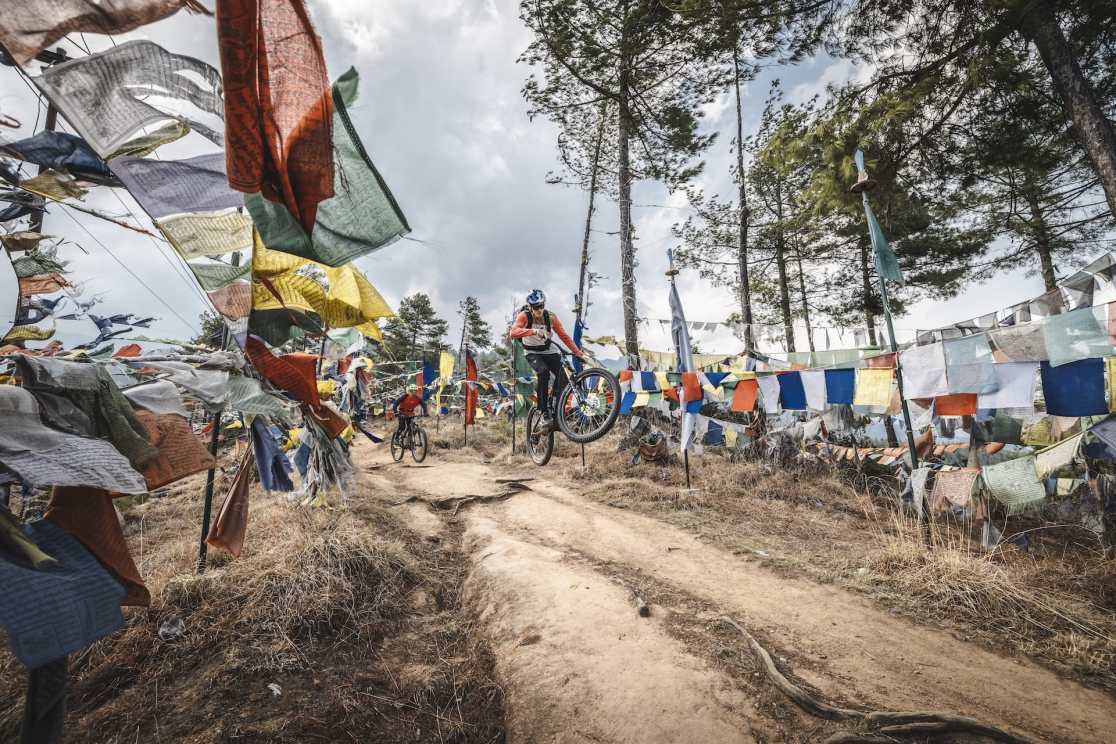

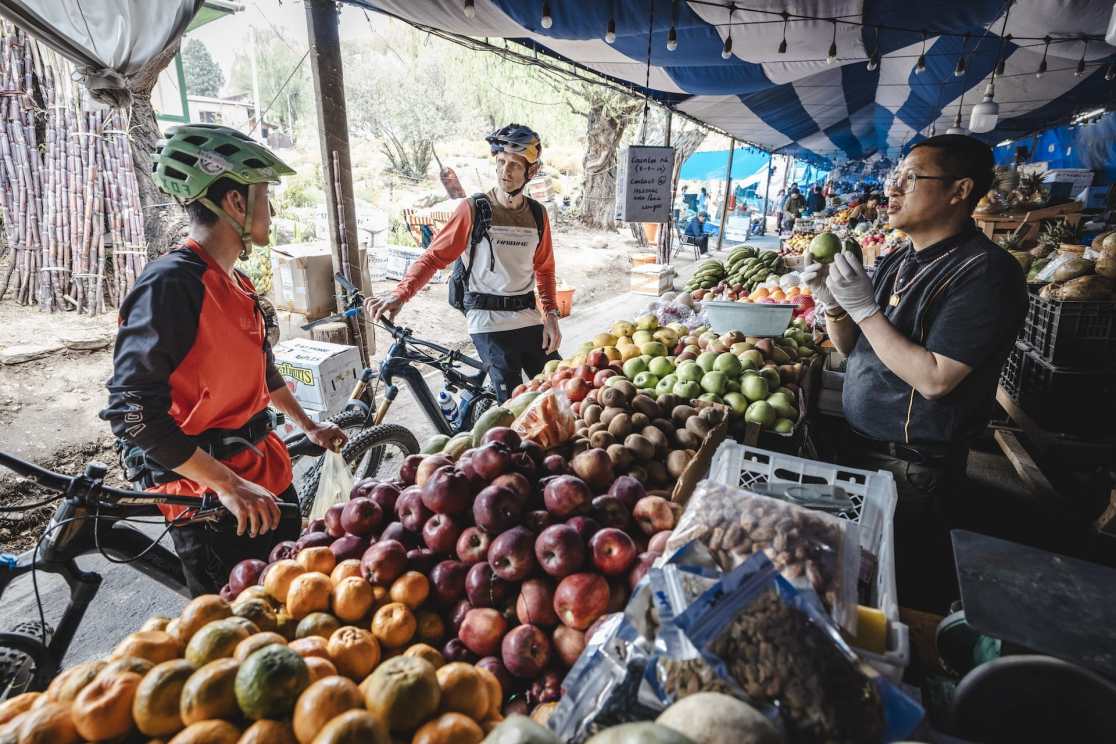

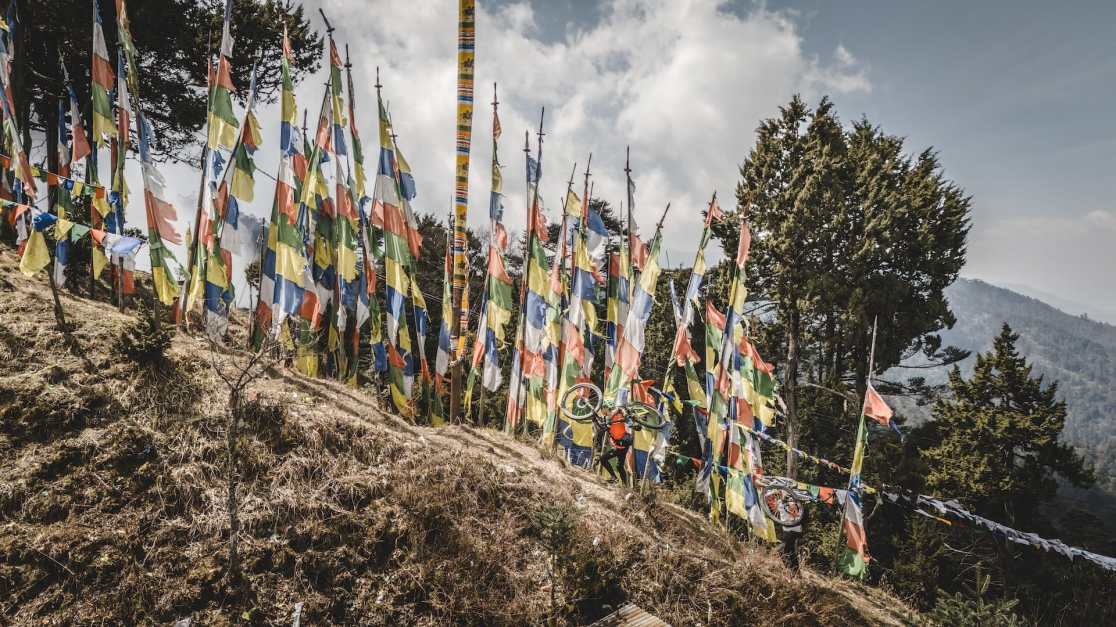
Half an hour later, the contrast to Bitcoin couldn’t be greater. Arriving at the monastery, we unload our bikes. The Madman Trail begins here. The monks admire Tom’s riding skills, and the ice quickly breaks. We tour the monastery, receive a blessing from the head monk, and begin our ascent. Through dense forests, we push and ride our bikes on muddy ground until we reach another abandoned sanctuary after a few hours. Mist shrouds the monastery walls. Not a soul in sight. We couldn’t have wished for a more mystical setting.
“Here, at 3,500 metres above sea level, starts the Madman Trail. Over 2,000 metres of descent through various vegetation zones await us,” Tandin explains. Until a few years ago, this trail was forgotten. Together with members of the bike club, Tandin rediscovered and made the former footpath rideable. Where the name ‘Madman Trail’ comes from, Tom wants to know. “Don’t worry, I’ll explain later,” Tandin grins, pedals, and flies over the first root sections down to Dochu La Pass.
Penises Everywhere You Look
The first part of the trail down to the pass is incredibly flowy. The grippy forest floor is carpeted with roots. Occasionally we see tattered prayer flags hanging from the trees. Fast sections alternate with more technical parts. A jump here, a switchback there – simply brilliant! I look at Tom’s face and can immediately tell he’s loving it. We agree, we would never have thought we’d be riding such fantastic trails here. After a short break at the café//ACCENT// on Dochu La, we continue in a similar style. While we speed through a mossy primeval forest in the first part, the vegetation changes abruptly. We pass colourful rhododendron bushes blooming far above our known tree line. The rising temperature indicates that we’re gradually moving to lower altitudes.
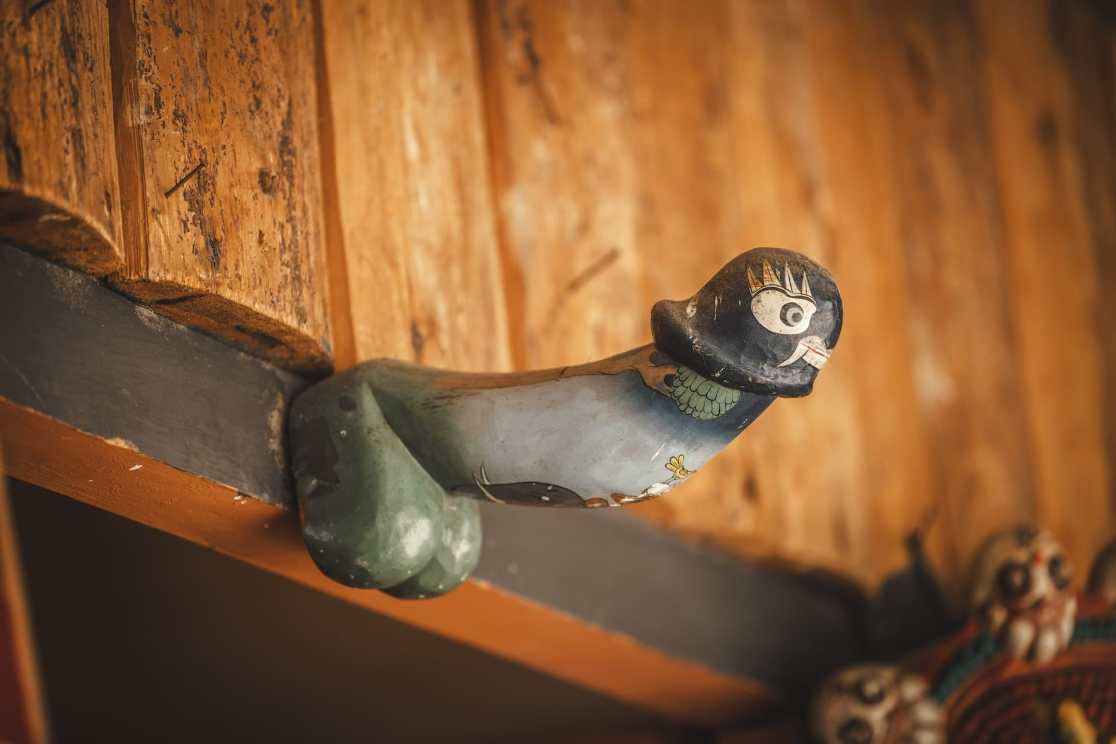
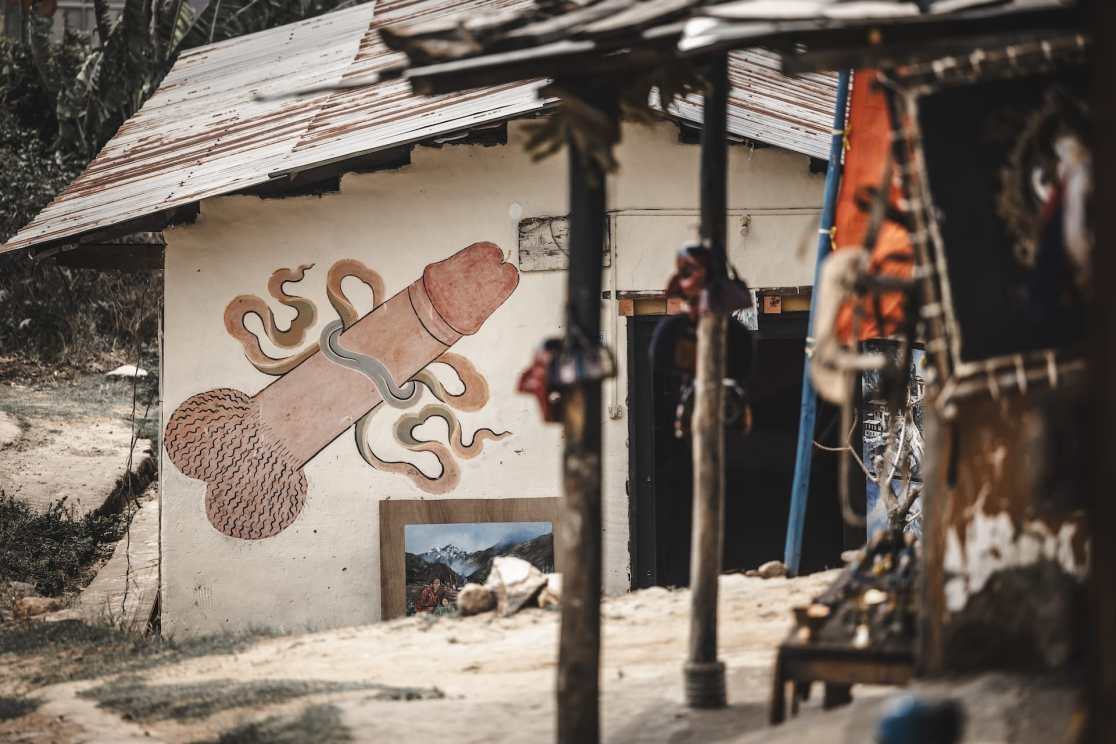
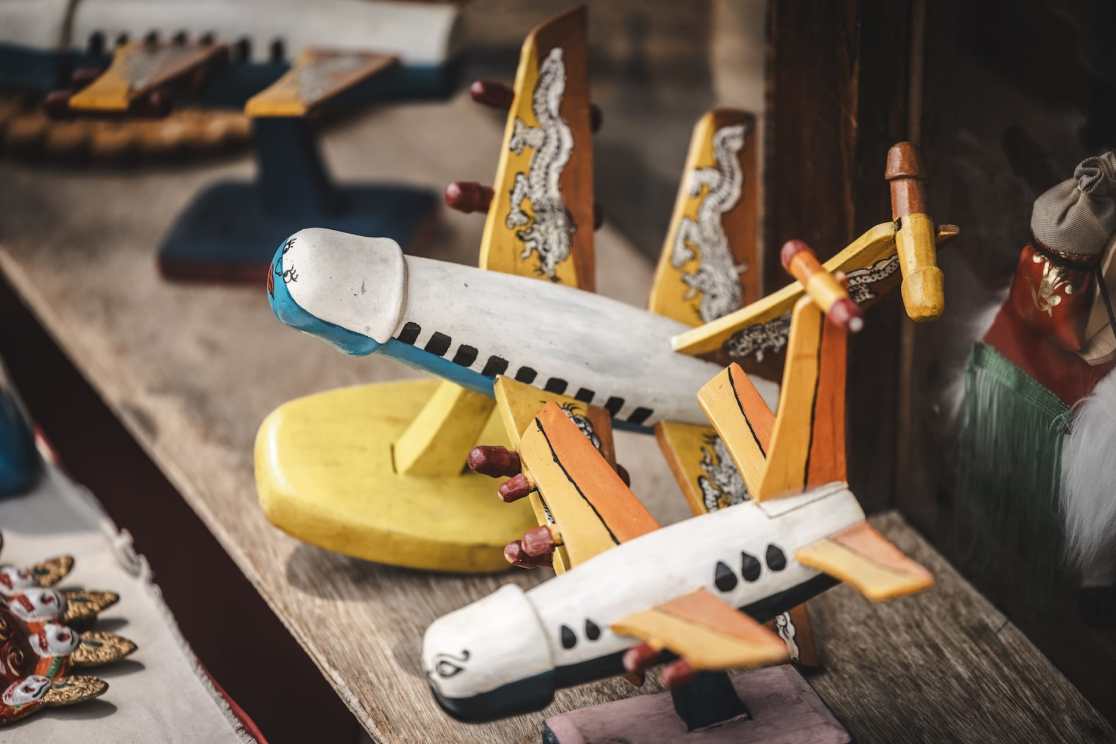
We cross the main road several times and reach a small village. Suddenly, there’s more activity. Minibuses with Indian tourists line up in a parking lot. A group of giggling Asian women pose in front of a house, taking photos. Tandin says it’s time to tell us the story of the Madman. Legend has it that 500 years ago a holy monk defeated a demon with his best part. Since then, phallic symbols have been painted on buildings or carved and hung at entrances to ward off evil spirits. It’s now known that penises not only drive away demons but also attract tourists.

We cruise through the streets, surrounded by penises of all shapes, colours, and variations. The village’s marketing activities seem to be paying off. Like all other tourists, we stop repeatedly, take photos, and buy souvenirs. What exactly we bought remains as secret as the Bhutanese Bitcoin industry, right, Tom?
The Royal Trail and an Unexpected Highlight
In Punakha Valley, culture is first on the agenda. Tandin swaps his bike clothes for traditional attire, as he won’t be admitted to the impressive monastery fortress without it. We witness a ceremony with monks, drums, and trumpets, and Tom receives a quick course in Buddhist history and religion from Tandin. Mentally strengthened, we are now ready for the Prince’s enduro trail.
After visiting the monastery, our driver shuttles us up the mountain over 1,000 metres. This is where the Prince’s trail, built a few years ago with the help of a military unit, begins. Tandin warns us that the trail hasn’t been maintained much recently. At the trailhead, we encounter dozens of workers finishing accommodations. “In two years, an Asian Enduro Series race will be held here,” Tandin explains. Not only are the houses unfinished but, unfortunately, so is the trail. The approaches and goodwill are visible, but on the half-finished, weathered, and partly overgrown trail, there’s not much fun to be had. “I think we should check this out again in two years,” Tom laughs.
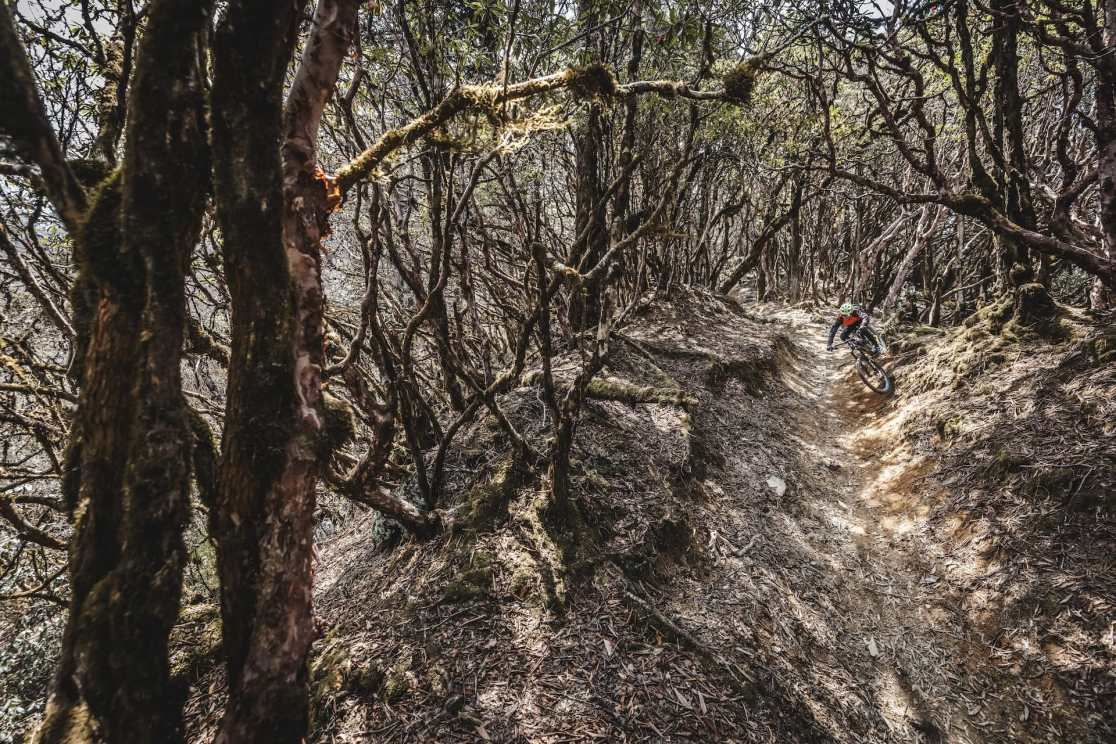
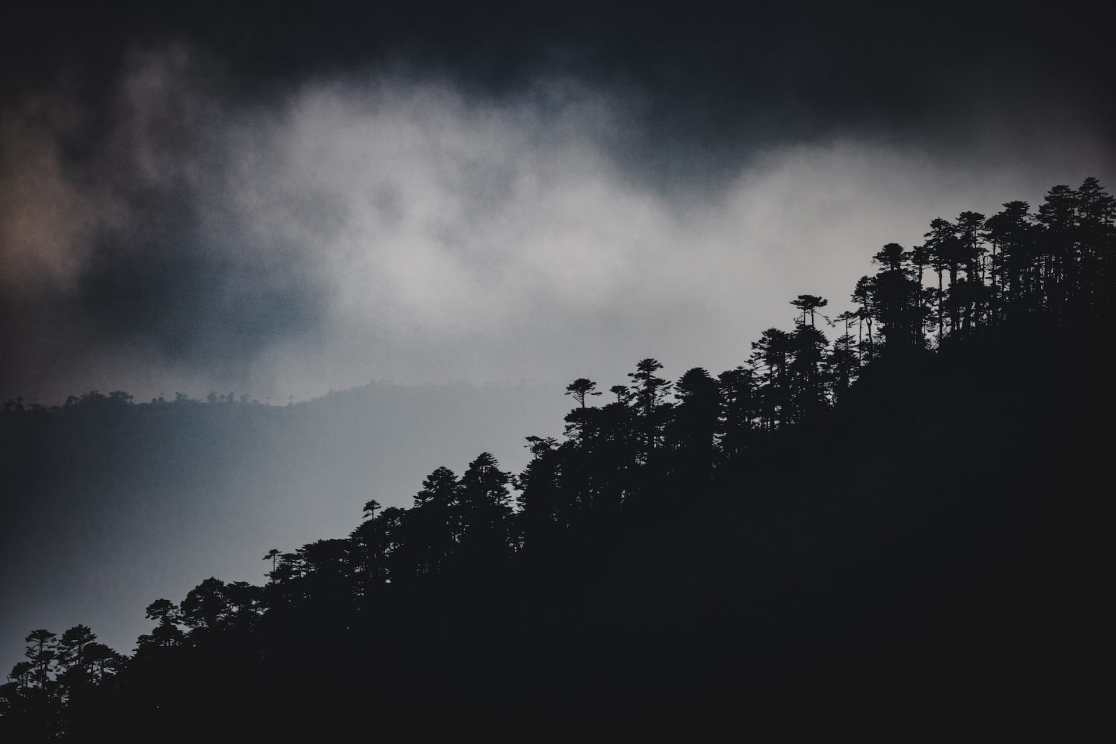
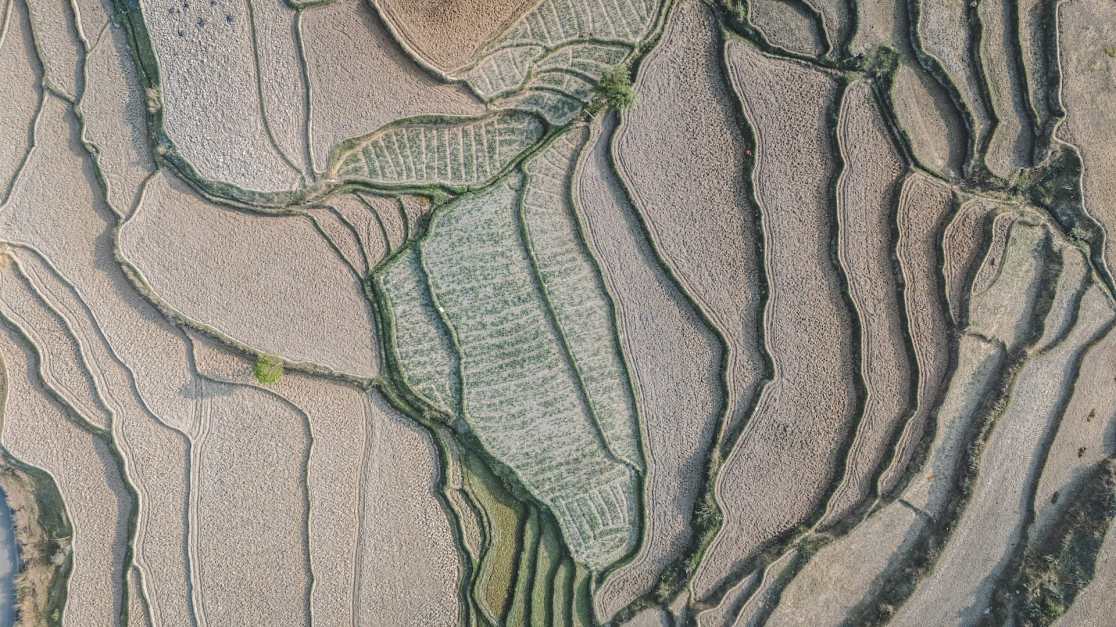
However, Tandin has one last ace up his sleeve, which he’s saved for the end. We head back to Thimphu and from there to Paro. In a small side valley lies Bhutan’s number one tourist magnet: Taktsang Monastery, also known as Tiger’s Nest, which clings to a cliff hundreds of metres high. Knowing that everyone undertakes this hike, we’re ready for the ascent well before sunrise. Two hours later, we stand in complete solitude at the viewpoint. This view alone is worth a trip to Bhutan! Before the first groups reach the monastery, we are already heading back. Instead of the wide footpath trodden by hundreds of visitors daily, Tom and Tandin repeatedly find shortcuts. The narrow paths are highly technically demanding. Tight turns, steep sections, and eroded ground offer the two enduro riders an ideal playground. We get surprised looks from oncoming hikers and occasionally a shake of the head. Mountain bikers are indeed a rare sight here. Seven hundred metres of descent later, Tom has made his verdict: “That was the coolest trail of the trip so far. If it weren’t for the countless tour groups, I’d go back up right now!”
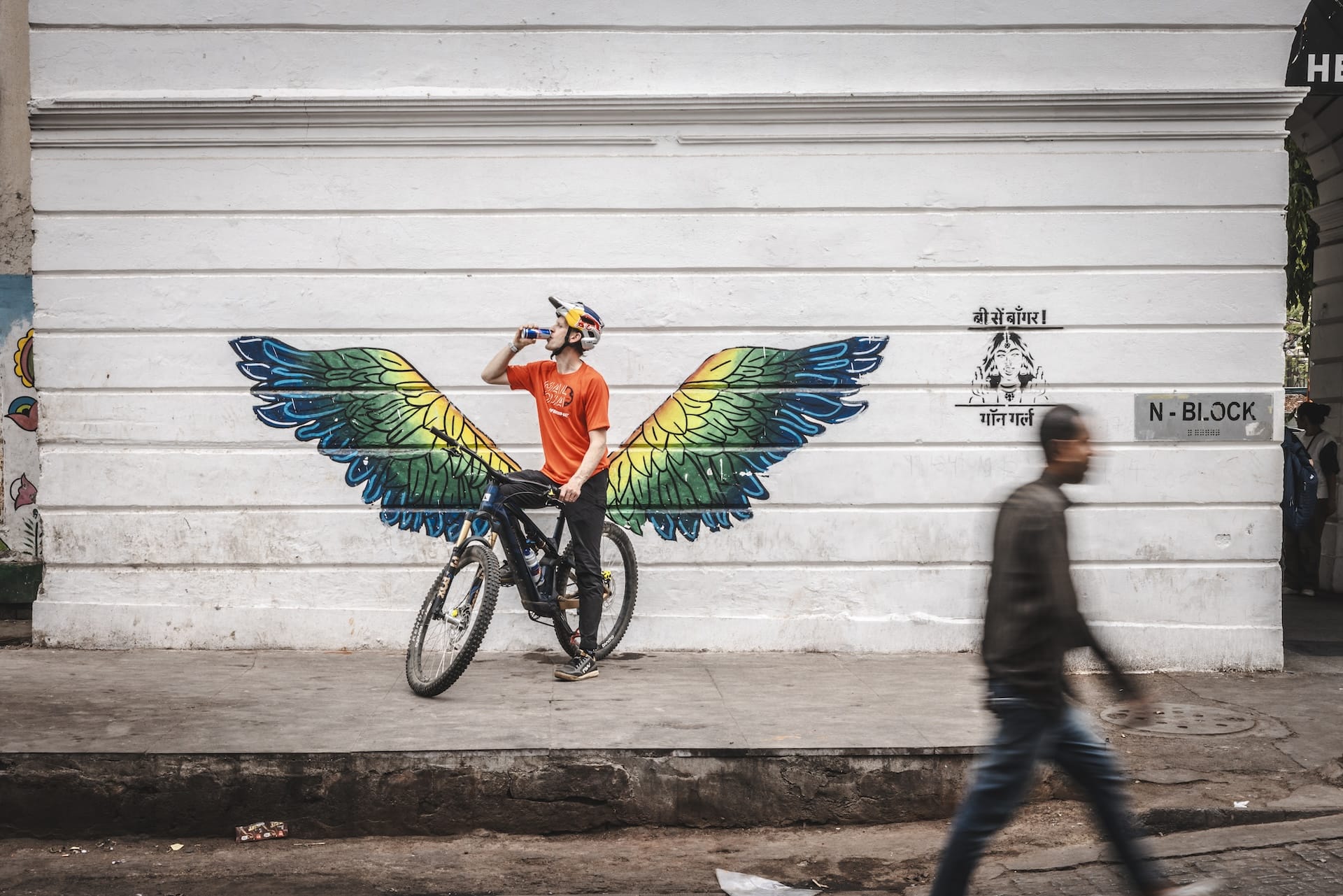
Archer Tom and a Fake Yak
We head back to our accommodation. On the way, we suddenly hear loud cheering. A group of men is enjoying archery, the national sport. Spontaneously, they invite us to join them. Join in both archery and drinking Chang, a local beer brewed from wheat and rice. Tom finds it not so easy to hit a target, even from 20 metres away. The local guys shoot from almost 150 metres, while the opposing team stands just steps from the target, trying to distract them with antics. We are amazed by the casualness and cautiously take cover in the farmhouse courtyard. “Have you ever danced with a yak?” Tandin suddenly asks Tom. “You mean the cattle?” Tom looks puzzled. “Sit down,” says Tandin, pointing to a wooden bench in front of the old house. As soon as they sit, the show begins. Masked dancers enter the area, accompanied by a farmer playing drums and flutes. Suddenly, a yak appears from behind the wall. The movements are deceptively real, and from a distance, it’s hardly recognisable that it’s a disguise. Tom takes a selfie with the yak. “I have to send this to my daughter, she won’t believe it otherwise,” he laughs. After 30 minutes, the spectacle is over. The dancers and the yak disappear as quickly as they had appeared. To top off the day, we’re invited into the farmhouse for a traditional dinner.
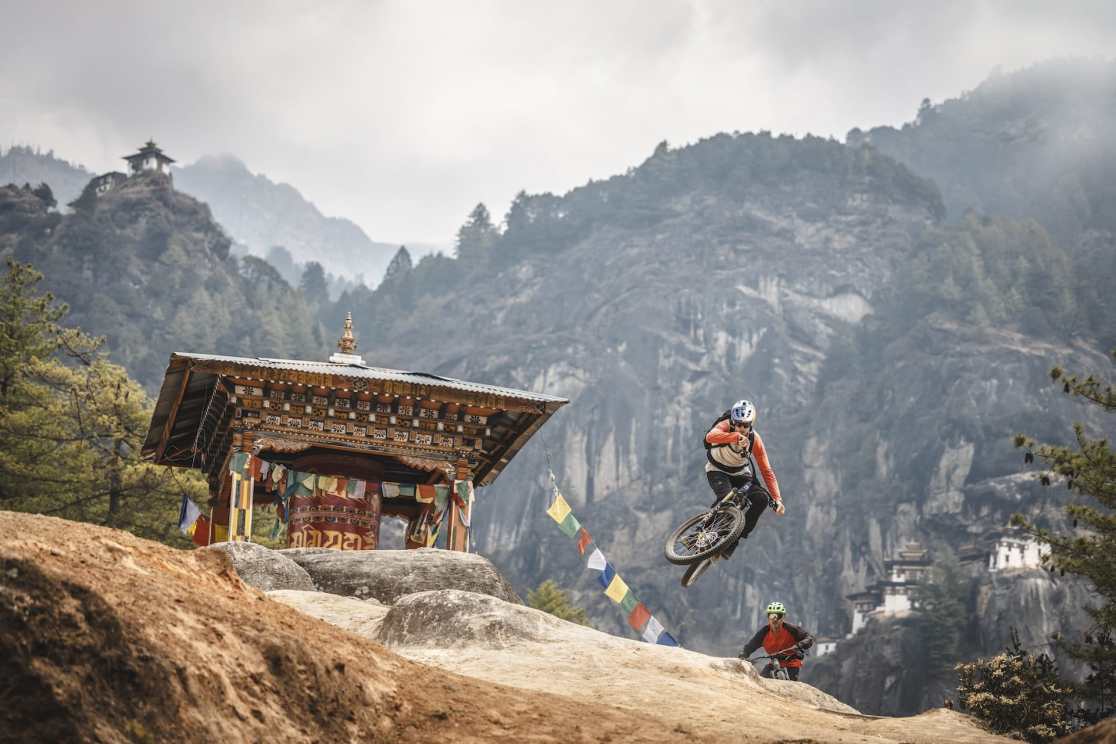
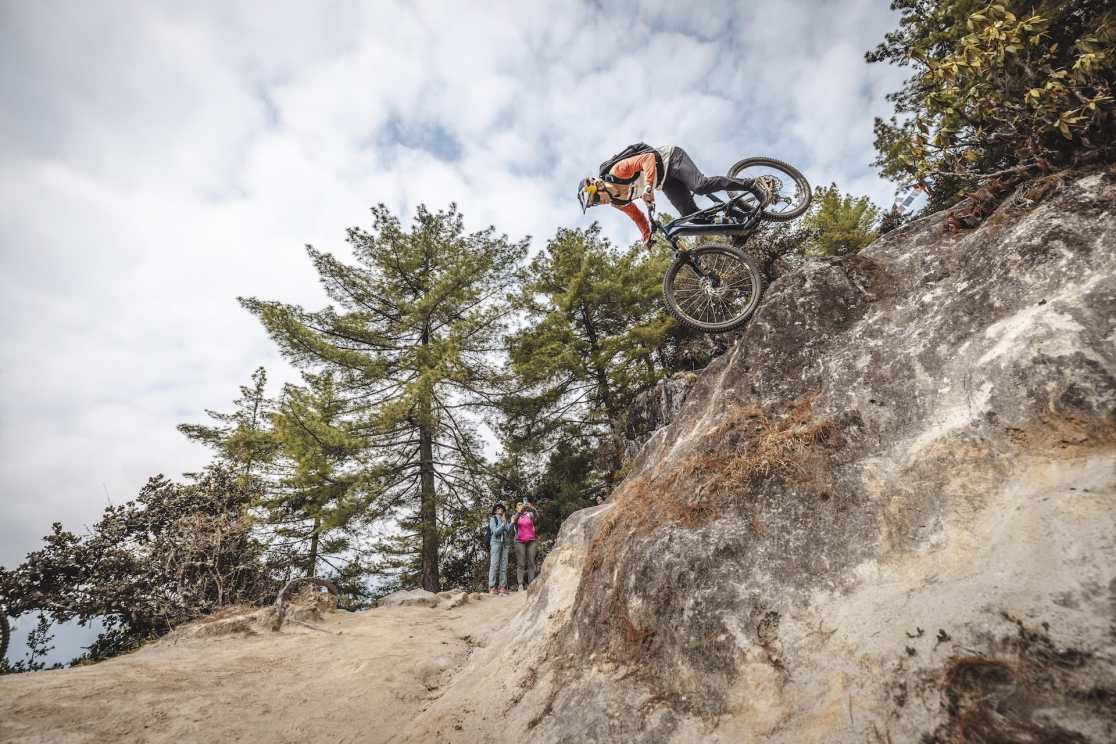

Happiness – or What You Make of It
On our last loop, we climb a pass almost 4,000 metres above sea level. At the viewpoint, we stand amid a sea of colourful fabric strips. Tandin opens his backpack and pulls out two rolls of prayer flags. “Here, Tom, for you. The flags spread goodwill and energy, carried by the wind, all over the world.” Soon, our journey home will begin. In just under two weeks, Tandin has shown us his favourite trails in Bhutan. We have seen a lot and yet only scratched the surface. Hundreds of untouched trekking routes are just waiting to be discovered.
We have learned much about Buddhist culture and the Bhutanese way of life. Are they really the happiest people in the world? We don’t know. Many young people seem to have sought their happiness abroad in recent years. Since the pandemic, emigration has massively increased. The grass seems greener in Australia or Canada for many exiled Bhutanese. But for Tandin, it’s clear – up here on a mountain bike, in the cold wind amidst prayer flags, looking at the trails ahead of us, this is true happiness. I look at Tom and we understand each other without words. At this moment, we absolutely agree with Tandin. We have found our happiness in Bhutan.
Need to know
Best Travel Time
The best time to visit Bhutan is in the spring (March to May) and autumn (September to November). During these months, the weather is mild and clear, ideal for hiking and cultural exploration.
How to Get to Bhutan
Most international travellers reach Bhutan via Paro Airport, which is served by a few airlines, including Drukair and Bhutan Airlines. There are direct flights from cities like Bangkok, Delhi, Kathmandu, and Singapore. A visa must be applied for in advance through a registered tour operator.
Language
The official language of Bhutan is Dzongkha. English is widely spoken and taught in schools, making it easy for tourists to communicate.
Individual Travel
Travelling independently in Bhutan is not allowed. To obtain a visa, a trip must be booked with a guide and driver through a local agent.
• BTS offers customised trips for individual mountain bike tours (2–4 people). bhutantravel.com
• SCOTT Sports organises bike tours to Nepal and Bhutan: scott-sports.com/ca/en/travel/best-of-enduro-in-nepal-and-bhutan
